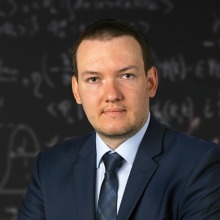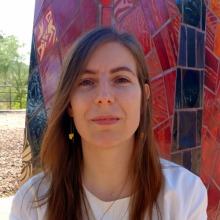Two College of Science faculty selected for Department of Energy Early Career Research Grants

In total, the U.S. Department of Energy announced the selection of 93 early career scientists from across the country who will receive a combined $135 million in funding.
The College of Science had two faculty members selected for the Department of Energy's Early Career Research Program (CAREER), a prestigious recognition for early career faculty with groundbreaking research: Dr. Nikolay Golubev from the Department of Physics and Dr. Lise-Marie Imbert-Gérard from the Department of Mathematics.
In total, the U.S. Department of Energy (DOE) announced the selection of 93 early career scientists from across the country who will receive a combined $135 million in funding for research covering a wide range of topics, from artificial intelligence to astrophysics to fusion energy. The University of Arizona had three of the 93 recipients in total. The awards are a part of the DOE’s long-standing efforts to develop the next generation of STEM leaders to solidify America’s role as the driver of science and innovation around the world.
Dr. Nikolay Golubev, Physics

Dr. Golubev received the CAREER funding from the Office of Basic Energy Sciences for his work on Unraveling Ultrafast Electron-Nuclear Dynamics in Molecules.
Research Summary:
Photoinduced molecular processes play a key role in physics, chemistry, and biology. In nature, light triggers a large variety of chemical reactions such as photosynthesis, vision, and the formation of vitamin D, but also can cause undesirable radiation damage. Furthermore, the interaction of light with mater forms the basis of important technological applications such as solar cells in which photoinduced charge transfer and light harvesting are essential. What all these processes have in common is capturing the energy of light and its transformation into other forms of energy like heat, electricity, or chemical energy. On a microscopic level, the energy conversion processes result from correlated motion of electrons and nuclei after photoexcitation or photoionization of a molecule.
Although much has been achieved in the understanding of fundamental physics underlying the electron-nuclear interactions and dynamics, the accurate numerical simulation of light-induced processes taking place in realistic polyatomic molecules remains an unsolved problem. The objective of this research is to develop both exact and approximate computationally efficient quantum dynamics methods capable of simulating the light-driven electron- nuclear dynamics in polyatomic molecules that account for non-adiabatic effects and include multiple electronic states. While the main focus is method development, all new methods are applied to describe properties and behavior of systems of physical, chemical, and biological interest, interpret recent experimental measurements, and guide future experimental efforts.
Learn more about Dr. Golubev and his research here.
Dr. Lise-Marie Imbert-Gérard, Mathematics

Dr. Imbert-Gérard's research on Quasi-Trefftz methods for problems governed by vector-valued Partial Differential equation was selected for funding by the Office of Advanced Scientific Computing Research.
Research Summary:
This project is concerned with the development of high-performance, efficient and robust techniques for the numerical simulation of complex physical phenomena governed by vector-valued variable- coefficient equations in three dimensions. On the one hand, it includes advanced computational methods for problems in strongly inhomogeneous and anisotropic media. On the other hand, it includes applications to plasma physics and aeroacoustics.
For instance, in the field of waves in plasmas, inhomogeneity comes into play in a non-uniform plasma – when its density is not constant – while anisotropy comes into play in a magnetized plasma – in the presence of an external magnetic field causing the plasma properties to vary depending on the direction considered.
The computational methods under consideration are called quasi-Trefftz methods. Trefftz methods are seeing a renewed interest in the scientific community as various techniques have recently been explored to tame an important issue of numerical methods based on wave-like basis functions, the well- documented issue of conditioning. Like them, quasi-Trefftz methods rely on local problem-dependent basis functions. However, unlike Trefftz basis functions, their basis functions are not exact solutions of the governing equation. They were precisely introduced to leverage the benefits of Trefftz methods while tackling problems governed by variable-coefficient equations, since exact Trefftz basis functions do not exist in general for such problems. This project will develop quasi-Trefftz methods for vector-valued equations in three spatial dimensions, both from the theoretical point of view and from the practical point of view.
Learn more about Dr. Imbert-Gérard and her research here.
To view the full awards announcement from the DOE, click here.

